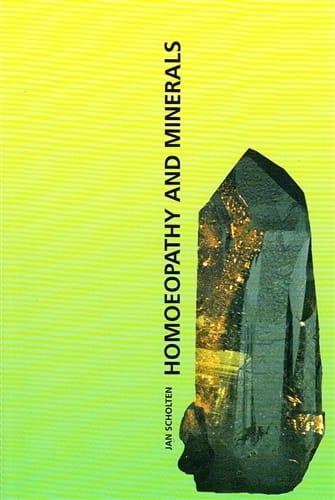Homoeopathy and Minerals
A brilliant book and a milestone of modern homeopathy. It was the first step to a deeper understanding of the mineral remedies in our materia medica. This is achieved by analysis of the individual components of the salts (such as Calcium, Natrium, Manganum, Muriaticum, Carbonicum, Bromatum, etc.). Scholten called this method group analysis. If we understand the themes of the individual components, we can predict the qualities of any possible compound using these building blocks. This led to the introduction of many new remedies (for example, Calc-m) into homeopathic therapy. They have since been successfully prescribed worldwide to thousands of patients. This work was the first step to the Element Theory, which is described in 'Homoeopathy and the Elements'.
The method of analyzing used in this book is of the highest importance. The method is called 'Group analysis'. The essential characteristics are extracted from a group of remedies with the same element, for instance Natrium. These characteristics are then applied to all the Natriums like Natrium fluoratum. This group analysis makes it possible to predict the homeopathic pictures of unknown remedies. It's a creative way to handle the huge amount of information in homeopathy. The reader of this book will be able to advance on the road of developing new pictures with the aid of the group analysis.
'When I met the ideas of Jan Scholten for the first time in December 1992, I was surprised: enormous possibilities offered themselves. Now, some months later, having had experiences with these new remedies, I can speak of a fundamental revolution in homeopathic thinking. The method Jan is offering in his book, seems too beautiful to be true, but it works! It is not easy to explain his method briefly, but I shall try to do so with an example from his college in February 1993. A woman of 30 comes with a variety of complaints, such as allergy to the sun, pain in the right forehead, sciatica right, intestinal troubles, swollen and painful breasts before menses, and fatigue. Mind: she needs attention, and compliments. I didn't dare to ask for attention and got irritated when my husband didn't say anything of my work. My mother had too little time for us and I was the one who managed. I was a big girl. The theme of attention is found in the Muriaticums, and the timidity and insecurity in the Calciums. The remedy: Calcium muriaticum (desire for attention, but not daring to ask for it). The woman got cured after the remedy. By analysing different minerals (Calcarea, Natrum, Phosphorus, Sulphur, Baryta etc.) and metals Jan has developed some key concepts for every element. In practice it is possible to make many combinations of these concepts and so find the remedy that fits the patient. Try to imagine what it means once we have found the key concepts of every element of the periodic system .... Maybe that is what Kent felt when he said that all remedies could be found in one kingdom (mineral, plant or animal). The work of Ary Vrijlandt, who has studied the periodic system in his own way, can get its own place. This book gives us the start. We practising homeopaths now have the job of verifying and expanding this information. A huge task and a fantastic challenge.' Frans Kusse SSC (Dutch Homoeopathic Journal).
- Author: Jan Scholten
- ISBN: 9789074817011
- 295 pages
- Paperback
- Published in 2005
- Printed in Netherlands

